研究成果
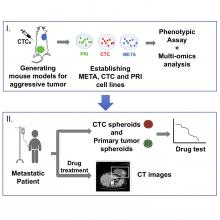
Oct, 2022
Matching the treatment to an individual patient’s tumor state can increase therapeutic efficacy and reduce tumor recurrence. Circulating tumor cells (CTCs) derived from solid tumors are promising subjects for theragnostic analysis. To analyze how CTCs represent tumor states, we established cell lines from CTCs, primary and metastatic tumors from a mouse model and provided phenotypic and multiomic analyses of these cells. CTCs and metastatic cells, but not primary tumor cells, shared stochastic mutations and similar hypomethylation levels at transcription start sites. CTCs and metastatic tumor cells shared a hybrid epithelial/mesenchymal transcriptome state with reduced adhesive and enhanced mobilization characteristics. We tested anti-cancer drugs on tumor cells from a metastatic breast...

Oct, 2022
Alternative Lengthening of Telomeres (ALT) utilizes a recombination mechanism and break-induced DNA synthesis to maintain telomere length without telomerase, but it is unclear how cells initiate ALT. TERRA, telomeric repeat-containing RNA, forms RNA:DNA hybrids (R-loops) at ALT telomeres. We show that depleting TERRA using an RNA-targeting Cas9 system reduces ALT-associated PML bodies, telomere clustering, and telomere lengthening. TERRA interactome reveals that TERRA interacts with an extensive subset of DNA repair proteins in ALT cells. One of TERRA interacting proteins, the endonuclease XPF, is highly enriched at ALT telomeres and recruited by telomeric R-loops to induce DNA damage response (DDR) independent of CSB and SLX4, and thus triggers break-induced telomere synthesis and...
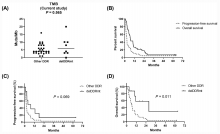
Oct, 2022
Although DNA damage response and repair (DDR) gene alteration has been demonstrated as a biomarker for anti-PD-1 therapy in several cancer types, its role in esophageal squamous cell carcinoma (ESCC) is unknown. Patients with advanced ESCC treated with anti-PD-1-based immunotherapy were enrolled. Tumor response was evaluated according to RECIST 1.1. Archival ESCC tissues were analyzed using FoundationOne CDx. Deleterious alterations, defined by loss of function, of DDR genes were correlated with patient survival by Cox proportional hazards model. The prognostic significance of deleterious alterations of DDR genes in The Cancer Genome Atlas (TCGA)-ESCC cohort was explored. Forty-three patients were enrolled. The objective response rate (ORR) was 19%. The median tumor mutational burden was...
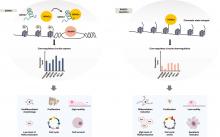
Sep, 2022
The small nucleolar RNA host gene 1 (SNHG1) is a novel oncogenic long non-coding RNA (lncRNA) aberrantly expressed in different tumor types. We previously found highly expressed SNHG1 was associated with poor prognosis and MYCN status in neuroblastoma (NB). However, the molecular mechanisms of SNHG1 in NB are still unclear. Here, we disrupted endogenous SNHG1 in the MYCN-amplified NB cell line SK-N-BE(2)C using the CRISPR/Cas9 system and demonstrated the proliferation and colony formation ability of SNHG1-knowndown cells were suppressed. The transcriptome analysis and functional assays of SNHG1-knockdown cells revealed SNHG1 was involved in various biological processes including cell growth, migration, apoptosis, cell cycle, and reactive oxygen species (ROS). Interestingly, the expression...

Sep, 2022
High blood glucose is one of the risk factors for metabolic disease and INS (insulin) is the key regulatory hormone for glucose homeostasis. Hypoinsulinemia accompanied with hyperglycemia was diagnosed in mice with pancreatic β-cells exhibiting autophagy deficiency; however, the underlying mechanism remains elusive. The role of secretory autophagy in the regulation of metabolic syndrome is gaining more attention. Our data demonstrated that increased macroautophagic/autophagic activity leads to induction of insulin secretion in β-cells both in vivo and in vitro under high-glucose conditions. Moreover, proteomic analysis of purified autophagosomes from β-cells identified a group of vesicular transport proteins participating in insulin secretion, implying that secretory autophagy regulates...
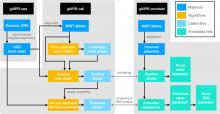
Sep, 2022
Adaptive immune receptor repertoire (AIRR) is encoded by T cell receptor (TR) and immunoglobulin (IG) genes. Profiling these germline genes encoding AIRR (abbreviated as gAIRR) is important in understanding adaptive immune responses but is challenging due to the high genetic complexity. Our gAIRR Suite comprises three modules. gAIRR-seq, a probe capture-based targeted sequencing pipeline, profiles gAIRR from individual DNA samples. gAIRR-call and gAIRR-annotate call alleles from gAIRR-seq reads and annotate whole-genome assemblies, respectively. We gAIRR-seqed TRV and TRJ of seven Genome in a Bottle (GIAB) DNA samples with 100% accuracy and discovered novel alleles. We also gAIRR-seqed and gAIRR-called the TR and IG genes of a subject from both the peripheral blood mononuclear cells (PBMC...
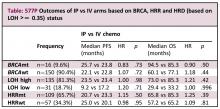
Sep, 2022
The iPocc randomised multicentre international study reported improved progression-free survival (PFS) but not overall survival (OS) with IP carboplatin and IV paclitaxel vs IV chemotherapy (chemo) in patients (pts) with epithelial ovarian, fallopian tube or primary peritoneal cancer. Previous studies suggested that pts with BRCA-deficient tumours may benefit from IP chemo. We conducted a non-prespecified analysis of the prognostic and predictive value of HRD in tissue samples retrospectively obtained from iPocc trial pts. 166 pts from participating centres in Singapore and Japan had adequate tissue for next-generation sequencing with ACT Genomics ACTOnco®+. HRD was defined by high loss of heterozygosity at a threshold of >=0.35 (LOH high) or presence of a pathogenic BRCA mutation (...

Sep, 2022
Liver fibrosis (LF) occurs following chronic liver injuries. Currently, there is no effective therapy for LF. Recently, we identified thioredoxin domain containing 5 (TXNDC5), an ER protein disulfide isomerase (PDI), as a critical mediator of cardiac and lung fibrosis. We aimed to determine if TXNDC5 also contributes to LF and its potential as a therapeutic target for LF. Histological and transcriptome analyses on human cirrhotic livers were performed. Col1a1-GFPTg , Alb-Cre;Rosa26-tdTomato and Tie2-Cre/ERT2;Rosa26-tdTomato mice were used to determine the cell type(s) where TXNDC5 was induced following liver injury. In vitro investigations were conducted in human hepatic stellate cells (HSCs). Col1a2-Cre/ERT2;Txndc5fl/fl (Txndc5cKO ) and Alb-Cre;Txndc5fl/fl (Txndc5Hep-cKO ) mice were...
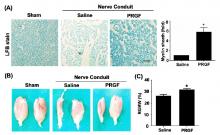
Aug, 2022
The failure of peripheral nerve regeneration is often associated with the inability to generate a permissive molecular and cellular microenvironment for nerve repair. Autologous therapies, such as platelet-rich plasma (PRP) or its derivative platelet-rich growth factors (PRGF), may improve peripheral nerve regeneration via unknown mechanistic roles and actions in macrophage polarization. In the current study, we hypothesize that excessive and prolonged inflammation might result in the failure of pro-inflammatory M1 macrophage transit to anti-inflammatory M2 macrophages in large nerve defects. PRGF was used in vitro at the time the unpolarized macrophages (M0) macrophages were induced to M1 macrophages to observe if PRGF altered the secretion of cytokines and resulted in a phenotypic...
Aug, 2022
Using the Taiwan Biobank, we aimed to identify traits and genetic variations that could predispose Han Chinese women to primary dysmenorrhea. Cases of primary dysmenorrhea included those who self-reported "frequent dysmenorrhea" in a dysmenorrhea-related Taiwan Biobank questionnaire, and those who have been diagnosed with severe dysmenorrhea by a physician. Controls were those without self-reported dysmenorrhea. Customized Axiom-Taiwan Biobank Array Plates were used to perform whole-genome genotyping, PLINK was used to perform association tests, and HaploReg was used to conduct functional annotations of SNPs and bioinformatic analyses. The GWAS analysis included 1186 cases and 24,020 controls. We identified 53 SNPs that achieved genome-wide significance (P < 5 × 10-8, which...